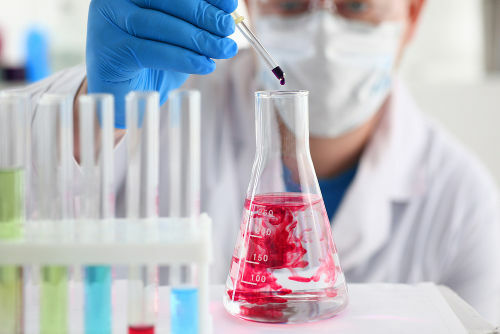Dilution consists of adding solvent to a solution, without changing the amount of solute.
In a dilution, the amount of solvent and the volume of solution increase, while the amount of solute remains the same. As a result, the concentration of the solution decreases.
Remember that the solution is a homogeneous mixture of solvent and solute.
Dilution is a common everyday process. For example, when we add water to some cleaning product, such as disinfectants, to make it less concentrated.
Another example is the preparation of juices from industrialized concentrates. It is indicated on the product label the amount of water that should be added, making the juice less concentrated.

To understand the dilution process, we must know the solution at its initial moment and after the addition of solvent:
- Initial concentration: Ci = m1/Vi
- Final concentration: Cf = m1/Vf
Where:
Ci / Cf = initial concentration / final concentration
m1 = mass of solute
Vi / Vf = initial volume / final volume
Considering that the solute mass is not changed during dilution, we have the following equation: Ci.Vi = Cf.Vf
To acquire more knowledge, be sure to read these texts:
- Solute and solvent
- Concentration of solutions
Solved Exercises
1. When diluting 100 mL of a solution with a concentration equal to 15g/L to the final volume of 150 mL, the new concentration will be?
Resolution:
Ci.Vi = Cf.Vf
15. 100 = See 150
Cf = 1500/150
Cf = 10g/L
2. 200 ml of an aqueous glucose solution of 60 g/L concentration were added to 300 ml of a glucose solution of 120 g/L concentration. The concentration of the final solution will be:
C1. V1 + C2. V2 = Cf. Vf
60. 200 + 120. 300 = See 500
Cf = 96 g/L
Read too:
- chemical solutions
- Homogeneous and heterogeneous mixtures
- Titration
Exercises
1. (UFV - MG) In relation to a diluted solution, we can state that:
a) It always has two components.
b) It has a lot of solute and little solvent.
c) It has a low concentration of solutes.
d) It has high molarity.
e) It always has more than two constituents.
c) It has a low concentration of solutes.
2. (UEL) 200 ml of potassium hydroxide solution with a concentration of 5g/L are mixed with 300 ml of a solution of the same base with a concentration of 4g/L. The concentration in g/L of the final solution is:
a) 0.5
b) 1.1
c) 2.2
d) 3.3
e) 4.4
e) 4.4


